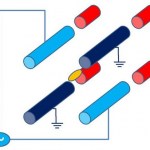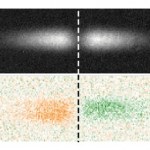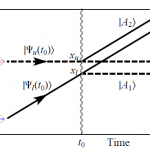Atoms and Molecules
The most talked-about physics paper last week was probably Negative Absolute Temperature for Motional Degrees of Freedom (that link goes to the paywalled journal; there's also a free arxiv preprint from which the above figure is taken). It's a catchy but easily misinterpreted title-- Negative absolute temperature! Below Absolute Zero! Thermodynamics is wrong!-- that obscures the more subtle points of what's going on here. So, in the interest of clarity, I'm going to attempt an explanation, over the course of a few posts, but given my schedule these days, that might spread over a couple of…
In which I unpack a cryptic paper title and explain how quantum superposition lets you use light to keep things from interacting with light.
-------------
I joined AAAS a couple of years ago to get a break on the registration fee for their meeting, and I've kept up the membership mostly because I like having individual access to Science articles, so I can read them in the coffee shops where I get actual work done. This also gives me access to articles in the "advance online publication" stage, which is hilarious because Union's institutional subscription doesn't include those articles-- if I'…
OK, it's a paper I mentioned here before, when it went up on the arxiv, but the "Comments on Atomic, Molecular, and Optical Physics" article I wrote this summer is up on the Physica Scripta web site now, and for the next not-quite-thirty days it's free to read and download:
Searching for new physics through atomic, molecular and optical precision measurements
We briefly review recent experiments in atomic, molecular and optical physics using precision measurements to search for physics beyond the Standard Model. We consider three main categories of experiments: searches for changes in…
In which we do a little imaginary Q&A to explain the significance of Tuesday's Nobel Prize to Dave Wineland and Serge Haroche.
------------
I did a quick post Tuesday morning noting that the latest Nobel Prize in Physics was awarded to two big names from my corner of the field. This would've been a great time to drop a long explainer post about what they did and why it's cool, but alas, I have a day job, and the Nobel committee stubbornly refuses to tell me who they're giving the prizes to in advance. Oh, well.
Still, I'm just vain enough to think I can add something a little different…
The 2012 Nobel Prize in Physics was announced this morning, going to Serge Haroche and Dave Wineland, "for ground-breaking experimental methods that enable measuring and manipulation of individual quantum systems". This isn't a pair that was getting much love from the prognosticators, but they're an excellent choice. And, in fact, commenter KSC correctly picked Wineland in the betting pool and narrowly missed also getting Haroche.
Wineland has been on my mental list of people who ought to get a Nobel for a while, especially because he easily could've had a piece of the 1997 prize for laser…
Last week, in the post about fermion conduction, I left a reference hanging:
There’s nothing physically blocking the atoms from flying right through the channel– in fact, an atom that enters the channel will always exit the other side without slowing down along the way. This is termed “ballistic,” a term that will always have a special place in my heart thanks to an incident at my Ph.D. defense.
Which was what? Let’s just leave that hanging to see if anybody actually reads this far. I can explain it in a comment if people want to know.
A couple of people asked for the explanation in comments…
So, it's been a while, but let's see if we can't hit the ground running with a good physics post. There have been a few notable physics events since I went on hiatus, but for a return to physics ResearchBlogging, we'll go with something near and dear to my heart, ultracold atoms. Specifically, this Science paper (free arxiv version) about passing atoms through a narrow channel. This is a cool bit of subfield-crossing physics, so let's dust off the Q&A format, and go through it.
Hey, dude, long time no see. So, what's the deal with this paper? Well, the title pretty much tells you what's…
In which we look at a slightly crazy-sounding proposal from my former boss, the experimental realization of which is getting close to completion.
------------
I spent more or less the entire first day of DAMOP a couple of weeks ago going to precision measurement talks. Most of these were relatively sedate (at least by the standards of a sub-field that routinely involves people proposing incredibly difficult experiments), but my boss when I was at Yale, Mark Kasevich, provided the bold proposals I usually expect, in this case suggesting an experiment using an atom interferometer to measure…
Richard Feyman famously once said that the double-slit experiment done with electrons contains everything that's "'at the heart of quantum physics." It shows both particle and wave character very clearly: the individual electrons are detected one at a time, like particles, but the result of a huge number of detections clearly traces out an interference pattern, which is unambiguously a wave phenomenon. The experiment has been done lots of times, but a particularly nice realization of it comes from Hitachi's R&D department, where you can see both still images and video of their experiment…
I finally got a copy of Cox and Forshaw's The Quantum Universe, and a little time to read it, in hopes that it would shed some light on the great electron state controversy. I haven't finished the book, but I got through the relevant chapter and, well, it doesn't, really. That is, the discussion in the book doesn't go into all that much more detail than the discussion on-line, and still requires a fair bit of work to extract a coherent scientific claim.
The argument basically boils down to the idea that the proper mathematical description of a universe containing more than one fermion is a…
The other controversial thing this week that I shouldn't get involved in is the debate over whether Brian Cox is talking nonsense in a recent discussion of the Pauli Exclusion Principle. Tom at Swans on Tea kicked this off with an inflammatory title, and Cox turned up in the comments to take umbrage at that. Sean Carroll provides a calmer and very thorough discussion, the comments to which include a number of well-known science popularizers duking it out.
My take on it is basically the same as Tom and Jim Kakalios in Sean's comments: unless the two particles you're talking about are within…
Newton's birthday (in the Julian calendar) is Sunday, so we're in the final days of the advent calendar. Which means it's time for the equations that are least like anything Newton did, such as today's:
This is the Schrödinger equation from non-relativistic quantum mechanics. If you want to determine the quantum state of an object that's moving relatively slowly, this is the equation you would use.
It also has probably the greatest origin story of any of the equations we've talked about. Or at least the most salacious origin story of any of the equations we've talked about...
Erwin…
Today's equation in our march to Newton's birthday is actually a tiny bit out of order, historically speaking:
This is the Rydberg formula for the wavelengths of the spectral lines in hydrogen (and hydrogen-like ions), with R a constant having the appropriate units, and the two n's being two dimensionless integers. This equation was developed in 1888 by the Swedish physicist Johannes Rydberg (who was generalizing from a formula for the visible lines of hydrogen that was worked out by a Swiss schoolteacher, Johann Balmer). As such, it pre-dates Einstein's equation from yesterday, but its…
One of the benefits of having joined AAAS in order to get a reduced registration fee at their meeting is that I now have online access to Science at home. Including the Science Express advance online papers, which I don't usually get on campus. Which means that I get the chance to talk about the few cool physics things they post when they first become available, without having to beg for a PDF on Twitter. This week's advance online publication list includes a good example of the sort of cool ultra-cold atom physics that I talked about at and after DAMOP, so let's take a look at this paper in…
Among the articles highlighted in this week's Physics is one about a new test of QED through a measurement of the g-factor of the electron in silicon ions. This comes on the heels of a measurement of proton spin flips (this includes a free PDF) a couple of weeks ago, and those, in turn, build on measurements of electrons from a few years back, which Jerry Gabrielse talked about at DAMOP. Evidently, it's magnetic moment season in the world of physics.
The media reports on the proton experiment tend to be a little garbled in a way that reveals the writers don't quite understand what's going on…
The final content area from my DAMOP overview is Precision Measurement. This is also the smallest area, with only one invited session on the topic on Fundamental Symmetry Tests, though two of the "Hot Topics" talks (by Zheng-Tian Lu and Ed Hinds) were precision measurement talks. You might be able to make an argument that this doesn't really deserve its own category, but I was the one giving the talk, and I love this stuff (though I absolutely do not have the temperament necessary to do it), so it gets its own category.
I also think there is a fairly distinct culture to precision measurement…
The fourth content area from my whirlwind overview of DAMOP is "traditional" AMO physics. This was the hardest to talk about in my talk, because I know it the least well, but ironically, that makes it really easy to write up here, because I don't have much to say about it.
Where the other areas were largely about using atomic, molecular, and optical physics to do stuff (simulating condensed matter systems, generating coherent x-rays, demonstrating cool quantum effects), this sub-sub-field is concerned with directly investigating the properties of atoms and molecules, usually by bouncing other…
Third of the five research categories within DAMOP that I talked about is Quantum Phenomena. This is a little bit of a catch-all, as there are a few different things going on in this area. They are all unified, though, by the fact that they end up making quantum mechanical effects manifest in some way, either as a means to an end, or just for the sake of showing that quantum mechanics is really weird.
What do I mean "making quantum mechanical effects manifest?" Basically, demonstrating one of the essential elements that I talked about last year: showing the wave nature of matter,…
The second in the DAMOP research categories I talked about is "Extreme Lasers," a name I was somewhat hesitant to use, as every time I see "Extreme [noun]," I get a flash of Stephen Colbert doing air guitar. It is, however, the appropriate term, because these laser systems push the limits of what's possible both in terms of the pulse duration (attosecond pulses are common, with 1as = 0.000000000000000001 s) and the pulse intensity (1014 W/cm2 is a typical order-of-magnitude, and some systems get much higher than that).
One of the main tricks for generating these ultra-short pulses is to do…
The first of the five categories of active research at DAMOP that I described in yesterday's post is "Ultracold Matter." The starting point for this category of research is laser cooling to get a gas of atoms down to microkelvin temperatures (that is, a few millionths of a degree above absolute zero. Evaporative cooling can then be used to bring the atoms down to nanokelvin temperatures, reaching the regime of "quantum degeneracy." This is, very roughly speaking, the point where the quantum wavelength of the atoms becomes comparable to the spacing between atoms in the gas, at which point the…




